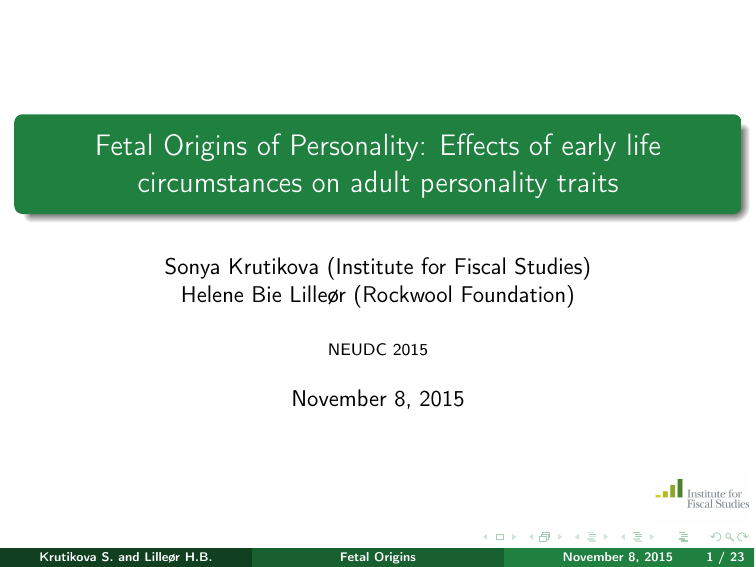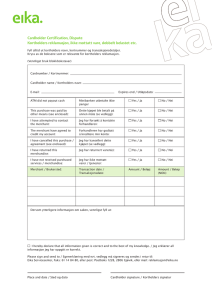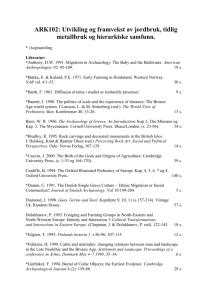Fetal Origins of Personality: Effects of early life
advertisement

Fetal Origins of Personality: Effects of early life circumstances on adult personality traits Sonya Krutikova (Institute for Fiscal Studies) Helene Bie Lilleør (Rockwool Foundation) NEUDC 2015 November 8, 2015 Krutikova S. and Lilleør H.B. Fetal Origins November 8, 2015 1 / 23 Main Question Can early-life conditions have a permanent effect on the formation and development of personality traits (/non-cognitive skills/socio-emotional skills)? Krutikova S. and Lilleør H.B. Fetal Origins November 8, 2015 2 / 23 Motivation Much less known about formation of personality traits than “cognitive” skills, despite importance for outcomes Just starting to see some evidence suggesting: (a) early life circumstances affect non-cognitive skill formation (b) technology is different from cog skills (material vs time investments) (e.g. Attanasio et al, 2015) Growing evidence on just how persistence effects of early life circumstances are on cognitive skills, health and socio-economic outcomes of adults (Overviews: Almond & Currie, 2011; Currie and Vogl, 2013) Very little to nothing on the core personality traits that we consider Krutikova S. and Lilleør H.B. Fetal Origins November 8, 2015 3 / 23 What we do Exploit exogenous variation in rainfall in a rural developing country setting (where livelihoods of majority of hh are dependent on rainfed agriculture) (Build on Maccini & Yang, 2009 + generation of papers since) Identify impact of being exposed to unanticipated deviations from usual seasonal rainfall pattern in early life on formation of personality traits of siblings in adulthood Utilise Kagera Health and Development Survey (KHDS): I I I 20 year panel (with tracking) detailed information on childhood & young adulthood linked historical rainfall data collected in nearby rainfall stations Krutikova S. and Lilleør H.B. Fetal Origins November 8, 2015 4 / 23 KHDS: Kagera Region Krutikova S. and Lilleør H.B. Fetal Origins November 8, 2015 5 / 23 KHDS Data and Sample 3 rounds, 6 waves: I I I 1991-94: 4 waves 2004: 1st follow-up 2010: 2nd follow-up Full sample: 915 baseline hh, in 51 villages ! 2010: 92% of baseline hh re-contacted - 3,300 hh Sub-sample that we focus on: I I I I born 1981-1993 in KHDS village In 1991-94 round and 2010 round Age in 2010: 17-29 One randomly selected respondent in this category per household !845 individuals Krutikova S. and Lilleør H.B. Fetal Origins November 8, 2015 6 / 23 Attrition Krutikova S. and Lilleør H.B. Fetal Origins November 8, 2015 7 / 23 Attrition Bias LPM of children being in sample in 2010 shows: I I I No correlation with baseline individual characteristics No correlation with main variables of interest: rainfall deviations in early life Some correlation with household characteristics: deceased parents / parent schooling, household size, value of land, sex of household head !within sibling analysis Krutikova S. and Lilleør H.B. Fetal Origins November 8, 2015 8 / 23 Personality Traits Collected data on three personality traits: I I I self-esteem: person’s overall evaluation of his/her own worth self-respect; self-worth, self-acceptance. (Rosenberg, 1989) self-efficacy: belief about link between one’s own behaviour and its consequences + one’s capability to behave or act to achiever desired outcomes. (Bandura, 1977) locus of control: beliefs about whether one can control events in one’s life. Linked to self-efficacy. (Rotter, 1966) Influenced by environmental factors (Trzesniewski et al, 2003) Evidence of impact on key outcomes (Carneiro et al, 2007; Goldsmith et al, 1997) Mechanism: Individuals with a more internal locus of control, higher self-efficacy and self-esteem are generally more active in improving their lives and work out ways of exercising some measure of control even in the face of limited opportunities (Bandura, 1966; Judge et al, 1998) Krutikova S. and Lilleør H.B. Fetal Origins November 8, 2015 9 / 23 Measuring Personality Traits Standard practice = to aggregating responses to sets of statements relating to a range of beliefs purported to reflect the traits of interest Selecting scales: combination of well-established scales & measures used in other studies in similar settings: I I I I Self-esteem: Rosenberg scale (Rosenberg, 1989) Locus of control: subs-set of items from Rotter scale (Rotter, 1966) Self-efficacy: scale used in the Young Lives 4 country study (incl Ethiopia) In total KHDS respondents were asked to indicate the degree of their agreement (on 4 point scale) with 22 statements Krutikova S. and Lilleør H.B. Fetal Origins November 8, 2015 10 / 23 Constructing the Outcome Measure Independence of concepts questioned in psych lit (Brockner, 1979)!we treat 3 scales as imperfect measures of latent personality trait - higher level core construct containing related elements of self-esteem, self-efficacy and locus of control called “core self-evaluation” (Judge et al, 1998) Definition of CSE = A trait that reflects and individual’s evaluation of their abilities and own control. Items with high loading for first factor from all 3 scales Use predicted first factor as the measure of latent trait which we call CSE - standardised to have mean 0 and sd 1. Measure behaves consistently with findings in the literature (positively correlated with years of schooling + being in the healthy BMI range) (NLSY, Judge&Hurst, 2008). (Results hold for individual measures as well though) Krutikova S. and Lilleør H.B. Fetal Origins November 8, 2015 11 / 23 Rainfall: Relevance Livelihoods of majority of households in the sample depend on rain-fed subsistence farming !rainfall patterns affect household income, consumption, work-load I I I Short-term: household consumption and income increase by more than 2 percent in response to a 10 percent increase in rainfall during the previous rainy season (biggest effect on food consumption) Longer-term: effects on non-food consumption and income - rainfall from 2 seasons before has larger effects on non-food consumption and income Bengtsson, JDE 2010: uses same data to show strong correlation btw rainfall and hh income, expenditure and profits. Shows an increase in body weight of female children as a result of an increase in hh income induced by rainfall fluctuations. Krutikova S. and Lilleør H.B. Fetal Origins November 8, 2015 12 / 23 Rainfall: Measurement Monthly historical rainfall data collected from 23 weather stations near KHDS villages for 1980-2010. Compares well to gridded rainfall data Village specific rainfall measure = inverse distance weighted interpolation procedure (3 closest sttns) Link rainfall data to individual’s month of birth. Periods of interest = the two rainy seasons in the 12 months preceding the birth (sum & individually) Measure = deviation of the natural log of early childhood rainfall over the relevant period from the natural log of the average over 10 years around the time of birth (1980-1990) Krutikova S. and Lilleør H.B. Fetal Origins November 8, 2015 13 / 23 Rainfall & Agriculture Bimodal rainfall: Masika rains March-May; Vuli rains Sept-Dec Substantial spatial and temporal variation Agriculture I I I I annual crops (beans & maize) = main source of food reliant on rainfall (Vuli rains) lean period = just before post Vuli rains harvest i.e. Oct-Dec previous Vuli harvest supplemented a bit by crops from Masika harvest ! but length & severity of lean period determined by previous Vuli rains and harvest Krutikova S. and Lilleør H.B. Fetal Origins November 8, 2015 14 / 23 Empirical Model Main equation: PTijvt = 0 + 1 Rainfallijv ,t 1 + 3 Sijv + 4 Maleijv +µj + kdt + "ijv 2010 PTijvt : adult personality traits for individual i, born in household j in village v , year t Rainfallijv ,t 1 is a measure of in-utero rainfall during the rainy seasons in the Vuli+Masika rains before birth Si controls for season of birth (rainy versus dry) µj is the sibling fixed effect (at least one parent in common) kdt is a district-year of birth fixed effect Krutikova S. and Lilleør H.B. Fetal Origins November 8, 2015 15 / 23 Identification Rainfall: exogenous fluctuation in environmental conditions District-year fixed effects: allowing cohort effects to vary by district Season fixed effects: seasonality of fertility Sibling fixed effects: systematic differences btw households in the way that they cope with shocks (e.g. parents with higher non-cog skills are better able to cope with shocks, more educated hh put off having children during bad rain years) Krutikova S. and Lilleør H.B. Fetal Origins November 8, 2015 16 / 23 Main Results (1) CSE (2) CSE (3) Self-esteem (4) Agency 0.808** (0.384) 0.828** (0.377) 0.588 (0.372) 0.894** (0.371) Rainfall deviation age 0-1 -0.109 (0.404) -0.083 (0.398) -0.123 (0.359) Rainfall deviation age 1-2 -0.266 (0.326) -0.413 (0.370) -0.189 (0.282) 0.019 (0.125) 741 Yes Yes Yes 0.029 (0.130) 741 Yes Yes Yes 0.055 (0.113) 741 Yes Yes Yes Rainfall deviation in-utero Male Number of observations Sibling fixed effects District * birth year fixed effects Season of birth dummy Krutikova S. and Lilleør H.B. 0.021 (0.127) 741 Yes Yes Yes Fetal Origins November 8, 2015 17 / 23 Robustness Correlation of rainfall over time: In-utero estimates remain stable in model with rainfall for 2 years prior to and 2 years after in-utero period Construction of outcome measures: pattern of results does not change if I I we use first factor from combining items from self-esteem and locus of control scales and for each one of these individually we standardise raw scores and use z-scores as outcome measures (core self-eval & individual scales) TO DO: Conley se’s to deal with spatial correlation Krutikova S. and Lilleør H.B. Fetal Origins November 8, 2015 18 / 23 Mechanisms: Timing Krutikova S. and Lilleør H.B. Fetal Origins November 8, 2015 19 / 23 Mechanisms: Timing −2 −2 Adult Core Self−Evaluation −1 0 1 2 Adult Core Self−Evaluation −1 0 1 2 3 Figure: Vuli 3 Figure: Masika 9−7 6−4 3−0 months pre−conception 1−3 4−6 7−9 months in−utero 0−3 4−6 7−9 months 1st year of life 9−7 6−4 3−0 months pre−conception 1−3 4−6 7−9 months in−utero 0−3 4−6 7−9 months 1st year of life Vuli rains effect and largest in first trimester of pregnancy but sig throughout in-utero stage Lean season from in-utero Vuli rains = months 4-12 of first year = weaning time (DHS: median duration of exclusive breastfeeding = 3.2 months) Krutikova S. and Lilleør H.B. Fetal Origins November 8, 2015 20 / 23 Mechanisms: Gender & Wealth (1) CSE (2) CSE (3) CSE Vuli rainfall deviation in-utero 0.721*** (0.269) 0.846** (0.327) 0.506* (0.258) Vuli rainfall deviation in-utero * Male -0.645*** (0.239) -0.204 (0.357) Vuli rainfall deviation in-utero * Older brother Vuli rainfall deviation in-utero * top 2 terciles by values of non-land assets Male -0.308 (0.277) 0.066 (0.073) Older Brother 0.037 (0.073) 0.033 (0.117) 0.127* (0.075) In top 2 terciles by value of non-land assets Number of observations Sibling fixed effects Village fixed effects District * birth year fixed effects Season of birth dummy Krutikova S. and Lilleør H.B. 897 No Yes Yes Yes Fetal Origins 466 No Yes Yes Yes 897 No Yes Yes Yes November 8, 2015 21 / 23 Other Outcomes in Adulthood Vuli rainfall deviation in-utero Vuli rainfall deviation age 0-1 Vuli rainfall deviation age 1-2 Male Number of observations Sibling fixed effects Village fixed effects District * birth year fixed effects Season of birth dummy Krutikova S. and Lilleør H.B. (1) Height (2) Chronic illness (3) School Years (4) Ln per capita consumption -0.770 (1.914) -1.459 (2.714) 1.093 (1.577) 9.883*** (0.565) -0.164 (0.121) -0.049 (0.094) -0.035 (0.074) -0.041 (0.040) 0.179 (1.031) 2.253*** (0.792) -0.678 (0.602) 0.594** (0.267) 0.305 (0.221) 0.105 (0.224) 0.102 (0.194) 0.245*** (0.071) 718 Yes No Yes Yes 741 Yes No Yes Yes 747 Yes No Yes Yes 742 Yes No Yes Yes Fetal Origins November 8, 2015 22 / 23 Next Steps Long-term effects consistent with recent finding in Yin et al that parents exhibit reinforcing behaviour in cognitive domain and equalising behaviour in health domain Disentangling biological effects of shocks from parental responses to shocks I Underestimating biological effect if parents exhibit compensating behaviour and overestimating if reinforcing Developing application of Yi et al (2015) methodology to use sibling data and assignable education and health expenditures to (a) disentangle behavioural and biological components of the effect and (b) test the hypothesis that parents compensate within health domain and reinforce within cog/non-cog domain. I I cross-sibling effects of shocks on health & education investments Estimate our main specification controlling for (instrumented) education and health investments in childhood to see whether rainfall deviation effect changes Krutikova S. and Lilleør H.B. Fetal Origins November 8, 2015 23 / 23

